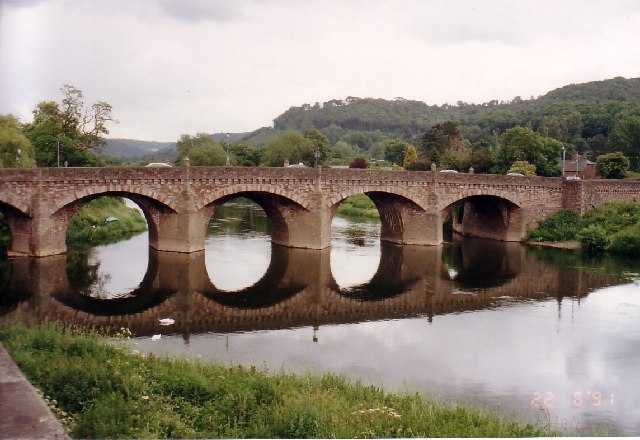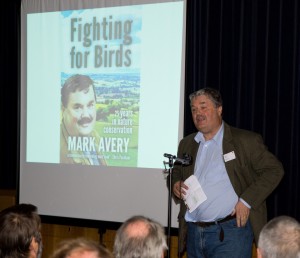

Last Saturday I drove into Wales, to Monmouth, to spend the day at the meeting of the Welsh Ornithological Society. I gave a talk and listened to lots of others.
This year is the 50th anniversary of the Gwent Ornithological Society so it was fitting that we were in Monmouth.
I enjoyed hearing from Al Venables about the birth and growing up of the Gwent Ornithological Society (by way of a couple of name changes) – I hope the GOS enjoy their 50s as much as I am enjoying mine.
There were some awards to some old people and a young person. Former colleagues of mine at the RSPB, Roger Lovegrove and Graham Williams were rewarded with lifetime achievement awards and Stacey Melia received the first WOS Student Research Award.
I enjoyed Steve Roberts’ talk on Honey Buzzards – just as much as I enjoyed it the previous weekend at the SOC Conference. And I am looking forward to hearing it again at the BTO Conference in December too. It really is a very good talk and if you are at Swanwick then look out for some superb photographs and some video footage that will blow you away. I won’t say more now.
Jerry Lewis gave a wonderful talk about a wonderful bird – the Hawfinch. I don’t see these birds very often and I enjoyed learning how they can be caught, a bit about their movements within this part of Wales but also further afield. It’s clear that there is, at least in some years, an influx of Hawfinches to the UK from Scandinavia. And they are gorgeous-looking birds.
Nigel Clark from the BTO talked about the Severn Estuary and ideas about barrages. It was interesting that he tended to favour tidal stream turbines as the way to harness the Severn’s tidal power that might, if done in the right way, be less damaging than the old-fashioned barrage proposals. This chimed with what Bob Furness said at the SOC Conference last weekend. It made me look up the study of one such tidal stream turbine that was put into the narrow entrance to Strangford Lough in Northern Irleand. This account, seems to suggest that it was quite a success. Maybe the Severn will be the site of hundreds of underwater turbines in a few decades time.
Tony Fox talked about the slightly complicated fate of the Greenland White-fronted Goose. Here’s an interview that Tony did with Brett Westwood that covers much of the ground. Apparently, it is only in England (where hardly any occur) and Wales (where there is an important wintering site on the Dyfi) that it is legal to shoot this bird. I’ve signed the petition to the Welsh Assembly to ask them to ban shooting of this species.
Thank you to WOS and GOS for a wonderful day.
![By Marek Szczepanek (Own work) [GFDL (http://www.gnu.org/copyleft/fdl.html) or CC-BY-SA-3.0 (http://creativecommons.org/licenses/by-sa/3.0/)], via Wikimedia Commons](https://markavery.info/wp-content/uploads/2013/11/Coccothraustes_coccothraustes_1_Marek_Szczepanek.jpg)
If figures can believed your readers may well make this petition more popular than John Armitage’s one. Interesting to see if everyone signs it. Then you have to ask the question WHY!!
It is startling how declines can be noticed over longer periods and I often find myself reminiscing to recently converted and younger birders on my local patch about what we used to see in the olden days. One of the species that was almost annual here in east Lancashire (or Greater Manchester) was the white-fronted goose. This was because there was a small wintering population on Anglesey at the time although they rarely reached double figures. Sadly, these birds are long gone and many GM birders need white-fronts for their county list. Similarly, we have lost all our grey partridges, wintering golden plover are rare probably because lapwing number have fallen, and it is now unusual to see species that were close to being annual visitors including breeding records for yellow wagtail. Disturbance is certainly an issue on site but it is noticeable that species showing national declines are harder to get these days.
However, it is not all doom and gloom (at least from a birder’s perspective) because we have half a dozen warblers breeding that would have been unknown or rare even twenty years ago. Common whitethroat, grasshopper warbler, chiffchaff (willow warblers were more numerous back then), blackcap, sedge warbler, reed warbler with less common but passage species such as lesser whitethroat and garden warbler. Interestingly, Autumn passage numbers of common redstart, spotted flycatcher and whinchat seem to be better and county records for black redstart and Cetti’s warbler have improved although neither is numerous.
I would really like to see a Hawfinch before I leave – it was my favourite within the pages of my Observers Book when I was a kid but I have never seen a live one. Maybe I should venture into the New Forest this winter?
Otherwise – I wonder what food I could put out in the feeders. The usual stuff attracts the usual suspects and with peanuts at £2100/t I’m loath to start attracting GSWs and rats again just on the offchance. A basket of blind cobnuts?
And btw – what species actually likes linseed? None, judging by the carpet of white on the ground this summer …
Filbert I haven’t been for a few years but if you live in the Hmapshire area the Blackwater Arboretum used to be brilliant for Hawfinches, it was a roosting site and when I went we saw about twenty birds, but things change,birds decline etc so check before going, as for attracting them to feeders I’ve heard “second hand” that cherries are a good choice as they love the kernels and best placed on the ground but that was from a slightly weird looking man. 🙂
“a slightly weird looking man”
This may apply to all cherry-pickers. However, I never pick cherries off our trees because the Black Cherryhawks always get them first.
I shall take up your recommendation for Blackwater though – I see they have some spectacular firs, Douglas
The white-fronted goose petition is not addressed to the Welsh Assembly, which does exist but has no direct power ion this, but to the Welsh Assembly Government, which doesn’t exist. It should be addressed to the Welsh Government, or the relevant minister/department. It worries me when people are so keen on a cause they don’t find out the right address to which to voice their concerns. Sign it anyway, though.
For non-Welsh readers: the Welsh Assembly is equivalent to the House of Commons. The Welsh Government is equivalent to the English government. Various matters are devolved to the WG, including planning, environment etc. Not defence or border controls, for example. Not that hard, really.
So Mark, urging people to write to their MP on environmental matters, as you did on Saturday, probably doesn’t work in Wales Or Scotland or NI. The MP could be the right person for UK wide policies on, say, energy, or if they are voting on English issues like Forestry Commission or the badger cull in England, or the import or export of something across UK borders, or how UK will vote or act in an international context.
But for any wildlife and environmental issues inside Wales, you’d want to contact your local councillors or AMs (Assembly Members), depending how local it is. In Scotland MSPs. In NI MLAs (I think?).
Paul – thank you and welcome.
I’m glad you would like people to sign the petition – it looks as though they are too.
Yes, i slipped up by not mentioning that when I said MP I meant to include all elected politicians – it slipped my mind. Saying MPs, MEPs. AMs, MSPs and MLAs each time would be a bit of a mouthful.
Filbert,think the Hawfinches get in the Arboretum in the New Forest(think it is called the Bolderwood Arboretum)in the late afternoon during the winter.
Blackwater and Bolderwood Arboreta are two different places – Blackwater on Rhinefield Drive south of the A35, Bolderwood directly opposite to the north. Both worth a try. Hawfinch are fiendishly difficult – I saw a lot around Santon Downham, Thetford Forest, when I worked in a shed in the engineering yard – they were quite easy to see (as easy as Hawfinch ever is) in early April – but by May they had disappeared completely – sure they were still there, but just very, very good at hiding. They must be one of the most frequent birds ‘missing’ from lists as only real hard work finds them – I wonder how many birders have long lists of American twitches but not Hawfinch.
In japan, I found they were really quite common and easy to see.
Jerry Lewis is a VERY impressive ornithologist.